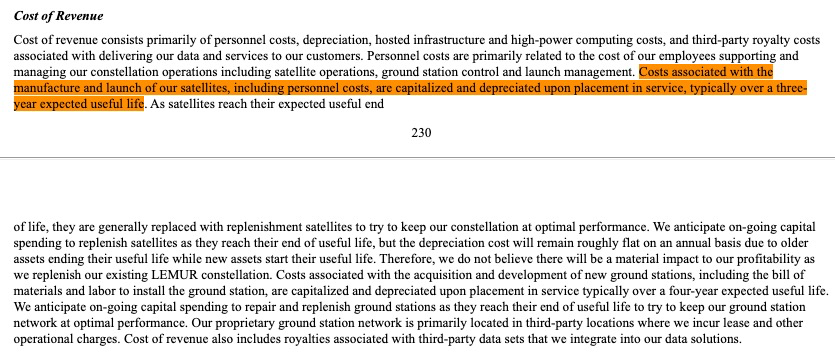
I have had a look at the SEC filings for @SpireGlobal, and I tried to understand what was the unit cost of the Spire satellites. Not an easy task... a thread. 1/16
In the SEC registration documents you can find a table listing the company property value and the related D&A. There I see that 'Satellites in service' represent 26,2M$ (p. F-43) 2/16
sec.gov/Archives/edgar…
sec.gov/Archives/edgar…

Let me assume that 'Satellites in service' are only those 3 years old or less in 2020, i.e. 62 satellites at end 2020. That is giving me a value per satellite in orbit of 420k$, launch included. But how much did @SpireGlobal pay for launch? 3/16 

This is unclear from the reporting. In fact at one point it states that cost of launch is capitalised (so it is included in the satellite book value of 420k$), but later on there is information on 'Launch Operations' costs. I haven't found an explanatory note for that. 4/16 

It is also not stated whether the Launch Operations cost applies to the satellites being amortised in the year or to the ones launched in the year. 5/16
If the Launch operations costs are applied to the averaged 46,5 satellites amortised in 2019 and 2020, they average 60k$/satellite. If they are applied to the satellites actually launched in 2019 (16) and 2020 (18), they represent 50 & 110k$ per satellite launched. 6/16 

So, shall I conclude that there is an additional cost of 50 to 100 k$ per satellite, on top of the capitalised value of satellites, due to 'Launch operations'? That's a lot... 7/16
It is also unclear why depreciation value is so low. Looking at Spire launch history with 3 years lifetime & linear depreciation, there should be the equivalent of 30 satellites to amortize in 2019 and 21 in 2020, with very different values each (resp 320 & 215k$/satellite). 8/16 

I also had a look at the cash situation, where I have learned that investing in infrastructure was 9,6M$ in 2020 and 8,9M$ in 2019. If most of that money went to fund the satellites launched in those years it represents a value of approx. 500k$/satellite. 9/16 

So what are my conclusions? 1) I think that each LEMUR satellite in orbit cost probably at least 400 and up to 500k$, launch included. 10/16
2) the launch cost is unknown, but probably in the order of 120 to 150k$ per satellite, which means that each satellite cost probably in the order of 250-350k$. 3) for a 3U cubesat weighting 4 to 5 kg, that's about 50-90k$/kg. 11/16
4) Is this value per kg a major breakthrough in satellite production costs? I don't think so. In fact it is in the same ball park of known prices of commercial satellites produced by 'legacy' satellite suppliers in the USA and in Europe. 12/16
5) If my assumptions are correct the launch costs are in the order of 120 to 150 k$/satellite, or 30 to 45 k$/kg, which is definitely not particularly cheap. But considering the launchers used (Antares, Atlas, Electron, H2, PSLV, Vega...) this is not a surprise. 13/16
6) Again I realize when looking at actual facts and financial data that the #newspace narrative on the drastic reduction of space infrastructure costs does not really stand. In fact, the path to space systems cost reduction seems to be very impervious and not well trodden. 14/16
7) That does not mean that @SpireGlobal cannot make a good business, actually, very much the contrary. @SpireGlobal can grow its customer base without needing to significantly expand its infrastructure, so there are probably good margins for improving its gross profit. 15/16
8) Of course @SpireGlobal would benefit from infrastructure cost reduction, but it is not a pre-requisite for financial viability. This is what makes the big difference with the emerging launch businesses where cost reduction is an absolute necessity for profitable growth. 16/16
PS: 400-500k$ per 3U cubesat in orbit seems really expensive. But I don't see how I can come to any other conclusion considering the values provided in the financial report. When I have some time I will see how @planet compares...
PPS: the actual number of "satellites in service" have been roughly averaged on per year basis. The results of the analysis would be more accurate if assessed against the exact launch dates. When amortising on 3 years actual launch dates can make a difference. launch list below. 

PPPS: The actual cost of launching the satellites has been wildly guessed. It could be much more or much less. The only 'sure' thing is that it includes 50 to 110 k$/satellite worth of 'launch operations cost' on top of the price paid for aunch service.
And here's a Q2 update on @SpireGlobal finances. Where we learn that revenues and gross profit are much lower than orginally projected.... But that is another story (but not a big surprise either).
businesswire.com/news/home/2021…
businesswire.com/news/home/2021…

• • •
Missing some Tweet in this thread? You can try to
force a refresh








